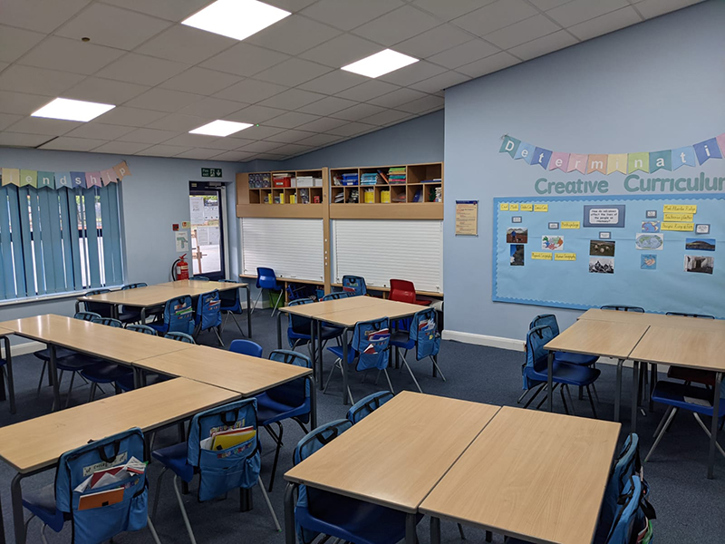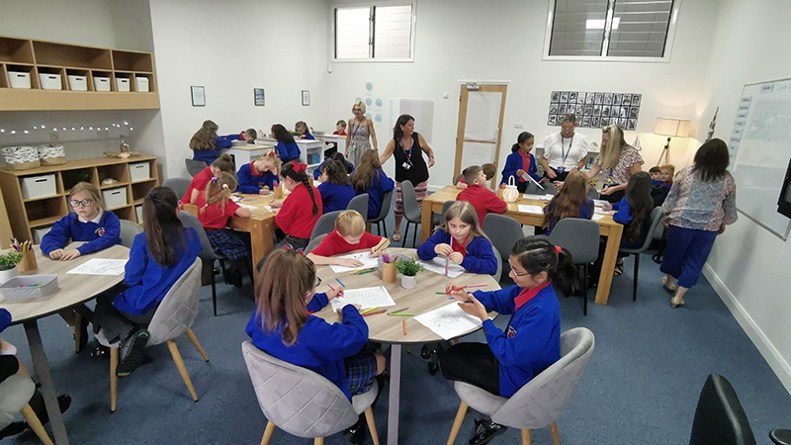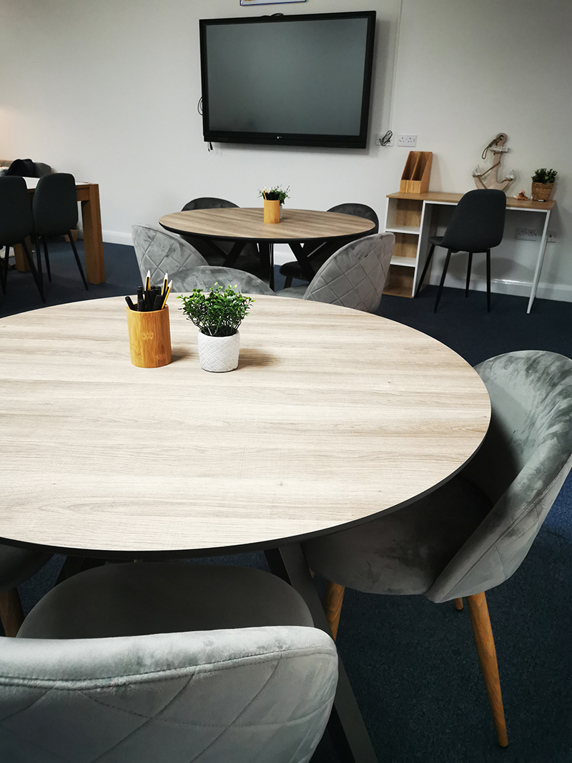
Too often, classrooms are uncomfortable spaces that are not even practical or functional. They do not meet the emotional, mental health or wellbeing needs of our children and can often increase feelings of anxiety, overwhelm and stress.
I am on a mission to create therapeutic, trauma-informed classrooms that help children feel safe and that provide them with the right atmosphere (and furniture) they need to flourish.
This year, I am working with a number of brave schools, who have given me free rein with their learning spaces to create therapeutic classrooms. This time, I would like to tell you about our work at Worsley Mesnes Primary School in Wigan.
Worsley Mesnes Primary School
With 233 children on role, Worsley Mesnes is a one-form entry school which is located in an area of deprivation. Helen Smart has been the headteacher for a year and is an incredible inspiration to her children and staff.
Helen went to a primary school around the corner when she herself was a child. She told her teachers that one day she would swim in the Olympics, and she did!
She has come back to the area to inspire the children, teaching them that they can do anything they put their minds to. The Olympic values run right through the school with Helen leading through example.
On my first visit, Helen told me that she doesn’t see this as an area of deprivation, but instead an area of potential and she makes sure her children know it. Her story is incredible and will feature in an upcoming episode of our reinventing classrooms series (see further information).
Helen asked me to transform her year 5 classroom, to support her vision to embed trauma-informed approaches across the school. Her vision is to transform every classroom over time.
What wasn’t working about the classroom

Unfortunately, due to the design and build of classrooms and standard educational furniture, there are many things about classrooms as a whole that don’t work. Helen’s school was no exception.
Lighting: The standard strobe lighting we see in classrooms can often leave children feeling internally unsettled and hyperactive. Many children in this year 5 classroom are struggling with adverse childhood experiences, others are living with autism. This means that they have high stress levels which can cause hyperactivity, anxiety, overwhelm and a feeling of not being emotionally safe. Bright lights can make children feel more overwhelmed and unsettled and do not help to bring calm to a space.
Tables: The standard tables in classrooms are often a hindrance. They can only be configured in specific ways and that means they take up a lot of floor space. In this classroom, the tables were arranged to meet the children’s needs as best as possible, however the room felt rigid and left some areas with very little space for the teacher and children to move around.
Chairs: For those of you who have read any of my previous articles, you will know that plastic school chairs are something I hate. They are uncomfortable and they cause children to fidget, become distracted, and actually create a barrier to learning. The chairs in this classroom had organisers on the backs which made them more uncomfortable for the children and looked untidy, which contributed to a feeling of disorder in the room.
Colour: Helen loves colour and her intentions for this room were good. She told me that she would like every room to have a calming colour on the wall as it makes the space feel more like a home. I understood her intention but gently challenged the school to think about other ways to help the room feel homely rather than adding colour to the walls.
Creating a therapeutic space with the children’s needs in mind

The children coming into this space have a range of emotional and mental health needs. This is typical of every school and my question is always: “How does the classroom meet the needs of the children?”
This is not about labelling our children. Instead, it is about recognising that everyone is coming into school with a range of needs that should be incorporated into the design of the room. If we truly want our children to learn, concentrate and do their best at school then we must consider what they need from the space.
In this class, we have children with ADHD, trauma, bereavement, neurodiversity and autism. It is important to consider how this might manifest in a classroom – feeling emotionally unsafe, struggling with challenge, feeling overwhelmed, struggling with sensory overload. In every room I create, I want the children to feel as though the room is for them, a place they can thrive and feel secure in.
After visiting the school, talking to Helen, the teachers, and the children, I set about re-designing the classroom, ordering the furniture, and buying the soft furnishings needed to transform the space. We then spent a day in the summer holidays transforming it.
The therapeutic classroom

The room is now warm, cosy, and inviting. Strobe lights are always turned off and the classroom is lit by natural daylight, and soft lamps and lanterns. The space feels calm which will help decrease stress levels and support the children’s rational thinking brain.
The tables are purposeful and allow for easy communication, team-work and group work. They foster a sense of belonging and togetherness. Most importantly, the chairs are comfortable and soft. The children can run their hands along the fabric while sat down, a form of self-soothing and self-regulation, and there are different types of seating options, allowing children to move around the room depending on their needs that day.
There is a calm area where children can break away if things are getting too much. They can pull on a blanket and listen to the class teacher while also feeling they have “opted out”, reducing the need to run out of the room.
When a child leaves a room because they feel overwhelmed, it is much harder to come back in. This space allows the children to manage their own emotional needs while never being excluded from the space. It also allows for reading, group work and one-to-one conversations or input. The children love this area the most!
The impact of the transformation
We spoke to the children after the make-over and they told us that the space felt safe and like home! They said they didn’t want to leave it and that they couldn’t believe this was their room for the year.
Walking around the room, you can feel how calm everyone is and can see the children are engaged and on task. Feedback from parents has been positive as well. I will Helen explain the impact more fully:
“We have seen the benefits of this room in such a short space of time – the children are queueing up outside in the morning ready to come in. Children who were previously reluctant to come in, are now here on time, ready to learn; children with additional needs are able to self-regulate and we have even experienced a child taking a nap on the couch for 10 minutes and then returning to their learning more refreshed! I would never have imagined it having such a positive effect on our children, but it does – it works!
The couch area is definitely their favourite part of the room. Every time I walk into year 5, there are always a couple of children sat on the couch with the coffee tables pulled up, working away with a blanket over their knee. Children also sit at the main tables either cuddling a cushion or with a blanket wrapped around them. We need to get a basket of blankets because they are a real hit.
We have had lots of visitors into school since the make-over, and every single one of them have said how calm our school is. We are aiming for all our classrooms to be therapeutic, but this will obviously take some investment at a time when budgets are very tight. We just have to be patient and keep chipping away.”
Investing in our children’s mental health and wellbeing is more important than ever. Transforming our environments is one way we can ensure we are supporting them holistically and can make a huge contribution to engagement and behaviour.
- Shahana Knight is director at TPC Therapy, a mental health service for children. Visit www.tpctherapy.co.uk. Find her on Twitter @Shahana_tpc. Read her previous articles for Headteacher Update, including previous diary entries in this series, via http://bit.ly/htu-knight
Further information & resources
- For an overview of the therapeutic approach, see: A calming, therapeutic classroom environment, Headteacher Update, January 2018: https://bit.ly/3iWlOfz
- For a video of the Worsley Menes work, visit https://www.youtube.com/watch?v=runIv8XulCs
- The Reinventing Classrooms YouTube channel can be found at https://bit.ly/3eW4R5O
